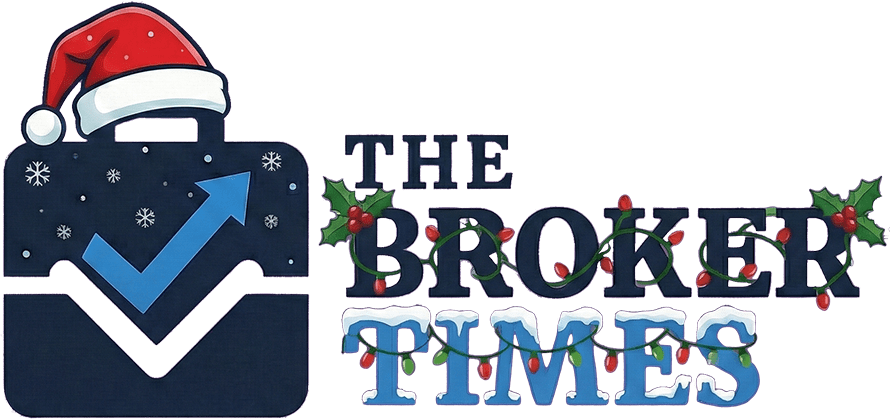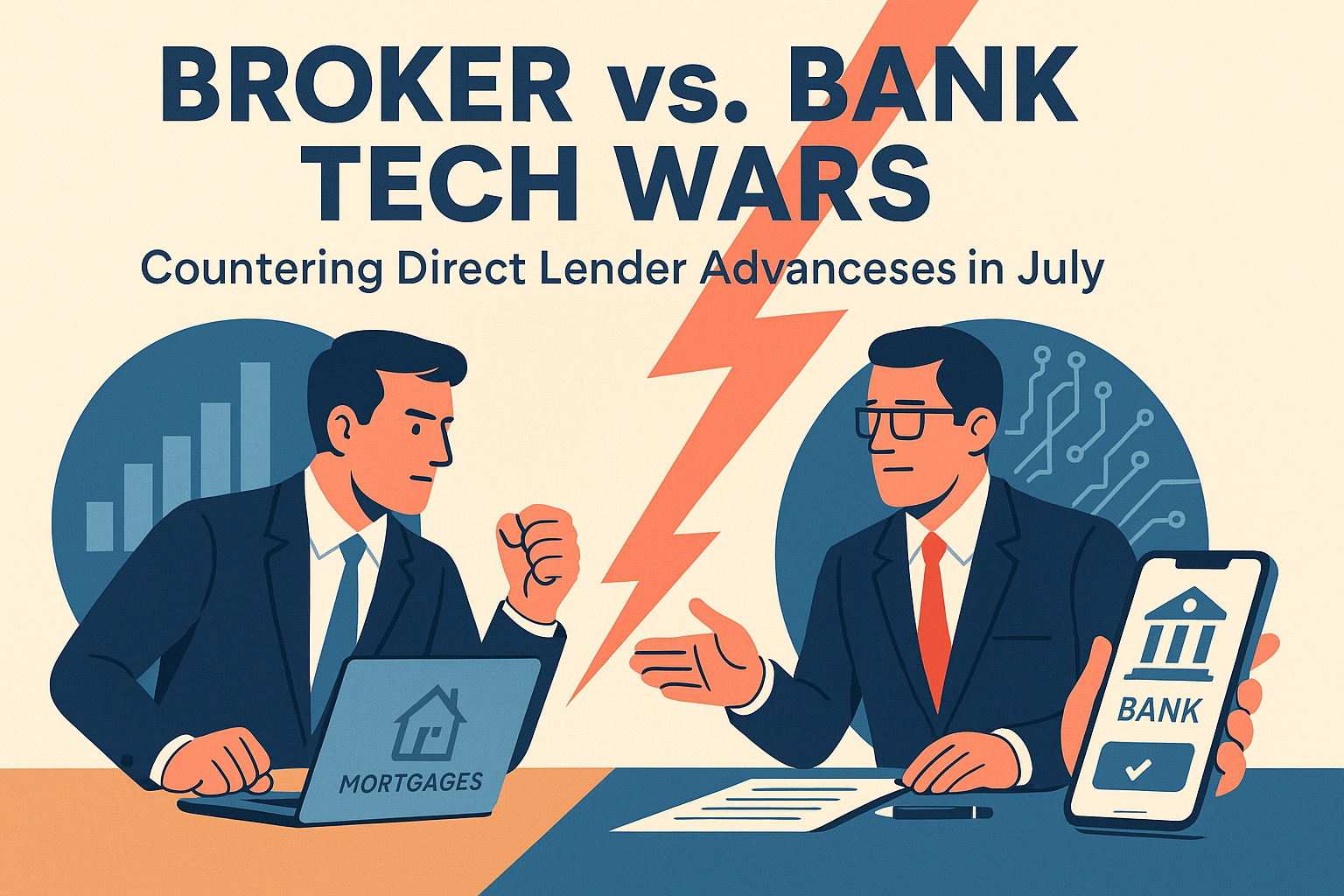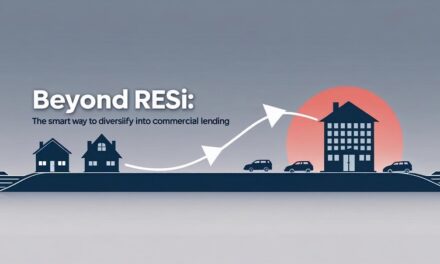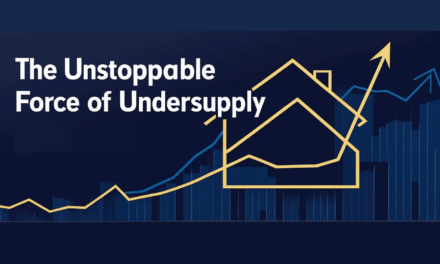Too Busy to Read? We’ve Got You.
Get this blog post’s insights delivered in a quick audio format — all in under 10 minutes.
This audio version covers: Beyond the Tech War: How Australian Mortgage Brokers Can Thrive in 2025
Broker vs. Bank Tech Wars: Countering Direct Lender Advances in July
The landscape of Australian mortgage finance is in constant flux, with ongoing discussions about how technological advancements by major banks might reshape the industry. Reports frequently highlight direct lenders leveraging digital channels, seemingly aiming to reclaim market share traditionally held by mortgage brokers. This narrative often frames the situation as a "tech war," positioning brokers against formidable institutional forces. However, a deeper analysis reveals that this perceived conflict is not an insurmountable threat but rather a strategic inflection point for astute brokers.
This report serves as a definitive guide, offering actionable strategies for brokers to not merely survive, but to strategically thrive and expand their market presence. The current period, July 2025, is particularly timely for such a discussion, marked by significant market movements, including recent Reserve Bank of Australia (RBA) rate decisions and strategic investments within the broader broker ecosystem. Understanding these dynamics and adapting effectively is crucial for brokers seeking to maintain their competitive edge.
In This Article
- Debunking the "Tech War" Narrative: Broker Resilience in Focus
- The Broker's Unbeatable Edge: Personalised Service & Market Mastery
- Leveraging Technology: The Broker's Strategic Advantage
- Fortifying Your Operations: Countering the "Leaky Funnel"
- The Power of Independence: Why Aggregator Neutrality Matters
- Key Takeaways for Brokers: Staying Sharp in a Dynamic Market
- Conclusion: Architects of Your Future
Debunking the "Tech War" Narrative: Broker Resilience in Focus
The notion that banks' technological advancements will inevitably lead to a decline in broker market share warrants closer examination. Industry leaders consistently challenge this perspective, asserting that banks' strategies to push brokers out through technology will "ultimately fail".[1] This expert consensus provides a robust counter-narrative to any alarmist views, underscoring that the fundamental value proposition offered by brokers remains resilient despite technological shifts within the banking sector.
The enduring strength of the broker channel is rooted in its capacity for high-quality personal service and specialized expertise, attributes that technology alone cannot replicate.[1] Recent data from June 2025 further substantiates this, placing broker market share at a "record high of 76.8 per cent," with the broker share of new business consistently ranging "around 70 to 80%".[1] These compelling figures provide critical evidence of the broker channel's current dominance and resilience. They demonstrate that despite significant bank tech investments, consumers overwhelmingly continue to choose brokers, making the idea of brokers being "pushed out" appear "far from reality".[1]
Furthermore, the economic argument often made against brokers, particularly the suggestion that banks would pass on commission savings to customers if brokers were eliminated, has been widely dismissed as a "fantasy" by industry experts.[2] These experts contend that banks would simply retain such savings, rather than transferring them to consumers. Brokers, it is argued, provide "better outcomes, better advice, and genuine choice".[2] They undertake the "heavy-lifting" of client acquisition, education, and retention, functions that banks would incur substantial costs to replicate through their proprietary channels.[2] This perspective dismantles the economic rationale for bypassing brokers, emphasizing their role in fostering competition and delivering invaluable services that reduce friction for both clients and lenders.
A critical observation often overlooked is the symbiotic relationship between banks and the broker channel, which is far from purely adversarial. There are numerous "banks with no or very few branches who thrive on broker business" [1], underscoring their reliance on the channel for significant volume. Brokers are, in fact, identified as a "vital piece of the puzzle in any major bank retention strategy".[3] Banks are actively "working hard to foster strong relationships with brokers and their clients" [3], including upgrading technology to streamline processes and enhance the "life-of-loan experience".[3] This crucial nuance reveals that banks are not solely competing with brokers; they are also strategically relying on them for substantial business, particularly in client retention. Their technology investments may also be aimed at improving the broker-facing experience, indicating a potential for collaboration and mutual benefit rather than outright conflict. The pervasive narrative of a "tech war" is often an oversimplification; while banks are indeed investing in technology, their aim is also to enhance their own internal efficiencies and customer retention, frequently through the broker channel. This reframing allows brokers to adopt a proactive, rather than defensive, mindset, setting the stage for strategic action.
The consistently high broker market share serves as a powerful, data-backed validation of the broker value proposition. It indicates that despite any "tech war" rhetoric, consumers overwhelmingly prefer the broker channel, reinforcing the importance of focusing on human-centric advantages. This strong market position is a clear indicator of consumer preference for the broker model, confirming that personalized advice and choice remain paramount.
The Broker's Unbeatable Edge: Personalised Service & Market Mastery
The qualitative advantages brokers offer, which advanced technology alone cannot replicate, solidify their position as indispensable client partners. Brokers unequivocally work for the client, not the banks, ensuring client needs are prioritized above all else.[4] This unwavering advocacy is a fundamental differentiator. Brokers provide genuine choice by offering access to multiple lenders—often over 30 lenders and thousands of loan products—leading to superior outcomes and tailored advice.[2, 4] The industry itself acknowledges that "customer experience will shape the future of broking" [5], underscoring the broker's evolving role as a "trusted adviser" who guides clients through complex financial decisions.[5]
Brokers' expertise allows them to provide crucial clarity and strategic guidance amidst dynamic market shifts. A significant development in July 2025 is the high probability of another 25 basis point RBA rate cut, potentially bringing the official cash rate to 3.60%, its lowest level since the pandemic era and the third cut in 2025.[6] This cut could offer "tangible monthly relief," estimated at $90-$100 in savings on a $600,000 mortgage, and substantial "psychological relief" for variable-rate home loan holders.[6] Brokers play a crucial role in helping clients understand whether banks will pass through the full rate cut (as funding costs remain elevated, not all lenders may do so) and in navigating the myriad of options available in response to these changes.[6]
Despite the RBA's likely rate cut offering financial "relief," the concurrent "all-time low" in refinancing activity [7] presents a critical opportunity for brokers to proactively engage clients. This suggests that financial relief alone does not automatically translate into client action; clients require guidance and clear options. This highlights a crucial role for brokers: to proactively reach out, educate clients on the benefits of the rate cut, and guide them through the refinancing process. This makes the broker's "trusted adviser" role even more vital in converting potential relief into actual business.
Beyond rate changes, emerging opportunities exist in specific market segments. Investor activity "rockets to a multi-year high" in the fourth quarter of FY25.[7] This indicates a significant and growing segment where brokers with specialized knowledge, particularly those focused on property investment, can provide immense value and capture new business.[8] The combination of a likely RBA rate cut and a surge in investor activity creates a prime, albeit specialized, market for brokers to target, particularly those who can offer strategic advice on property investment. The RBA's easing monetary policy is designed to "support demand" and "ease mortgage stress," which can make property investment more attractive.[6] This confluence of factors points to a significant growth niche. Brokers who can leverage this trend by specializing in investor loans can capture substantial new business, demonstrating their agility in adapting to market shifts.
The importance of hyper-local market knowledge, often referred to as the "postcode effect," plays a vital role in delivering truly personalized solutions. The average mortgage size climbed to $678,333 in Q4 FY25, with notable regional variations: New South Wales averaged $778,628 and Victoria $664,061.[7] This data reinforces the "postcode effect," where the volume of settlements needed to hit targets varies significantly by state. Brokers' deep understanding of local market conditions, property values, and client demographics allows them to tailor loan solutions that are precisely calibrated to their clients' specific needs and financial goals—a level of customization direct lenders often struggle to match.
Leveraging Technology: The Broker's Strategic Advantage
Instead of fearing bank technology, brokers can strategically adopt and integrate their own tech solutions to amplify their existing strengths. Technology, when correctly implemented, serves as the "central nervous system" of a modern brokerage and a "powerful competitive advantage." The objective is not to compete head-on with bank tech, but to enhance the broker's unique value proposition.
A clear framework for building a sophisticated and integrated technology ecosystem involves a "Hub-and-Spoke" model. The Customer Relationship Management (CRM) platform is positioned as the central "hub"—the single source of truth for all client and deal information. Specialized "spoke" applications are then integrated, each designed to address specific bottlenecks.
| Business Function | The Bottleneck It Solves | Example Tools |
|---|---|---|
| Core Platform (Hub) | Lack of a single source of truth; manual workflow management. | BrokerEngine, Salestrekker |
| Serviceability | Wasting hours manually comparing complex lender policies. | Quickli |
| Document Collection | High-friction, insecure email attachments; chasing clients for documents. | FinanceVault |
| Compliance (BID) | Treating compliance as a manual afterthought; managing trail book. | Sherlok (for repricing/reviews) |
| E-Signatures | Delays caused by printing, signing, scanning, and emailing documents. | DocuSign |
This roadmap translates the abstract concept of a "tech stack" into concrete, actionable examples for time-starved brokers.[9] By explicitly linking specific tools to the bottlenecks they solve, it provides immediate, practical guidance. This empowers brokers to identify areas for improvement in their own operations and select appropriate solutions, directly supporting the "Broker Growth & Tools" content pillar and offering immediate value.
Recent, impactful investments by aggregators are directly empowering brokers with advanced tools. In July 2025, Compass Aggregation acquired a 15% equity stake in Loan Garage, gaining access to its award-winning GaragePro CRM platform.[10] GaragePro offers features highly relevant to brokers, including a loan matching assistant with predictive scoring and pre-filled applications, a lender marketplace with live quoting across over 90 lenders, referral tools with white label portals and automated commission splits, a comprehensive compliance engine with AML/KYC automation, NCCP audit trails, and e-signatures, a marketing suite with CRM-integrated campaigns, open banking integration, multi-entity structures, and integrations with other key home loan platforms like Stryd, NextGen, Quickli, and CashDeck.[10] This demonstrates that aggregators are not merely providing basic services but are actively investing in sophisticated, broker-centric technology. Such investments enable brokers to "digitally scale and unlock new revenue streams without additional admin, licensing, or staffing" [10], directly enhancing their efficiency, compliance, and client experience.
Further evidence of this trend includes LMG's announced plans to purchase The Brokers' Bible in July 2025, a fintech designed to help brokers access policy information faster and easier.[5] Additionally, Connective launched a white label reverse mortgage in July 2025, further expanding product offerings available through aggregators.[1, 5] These recent aggregator moves illustrate a clear trend: aggregators are evolving into key technology enablers, providing brokers with advanced tools and diversified product options, thereby strengthening the broker channel's overall competitive stance.
These significant investments by aggregators directly challenge the notion of relying solely on an "Aggregator Crutch." Instead of being a dependency, aggregators are becoming strategic partners that provide advanced technological leverage for brokers. Brokers can strategically leverage these advanced, aggregator-provided tools to build their own competitive edge and differentiation, effectively transforming a potential dependency into a powerful strategic advantage. The comprehensive feature set of GaragePro directly addresses multiple operational bottlenecks and traps identified in the brokerage blueprint [9], demonstrating that practical solutions to common broker challenges are already being implemented through strategic tech partnerships.
The emerging potential of Consumer Data Right (CDR)-powered open banking for broker efficiency also represents a significant frontier. Open banking is identified as the "next frontier for broker efficiency" [5], with platforms like GaragePro already incorporating this integration.[10] This positions forward-thinking brokers at the cutting edge of financial innovation, leveraging data to streamline processes, enhance accuracy, and provide even more precise, tailored advice to clients.
Fortifying Your Operations: Countering the "Leaky Funnel"
Beyond external competition, a crucial internal battle against operational inefficiencies can be more detrimental to growth than any direct lender advances. This involves addressing the "Leaky Funnel".[9] Data reveals a projected plummet in the conversion rate from pre-approval to settlement, from 60.5% in FY22 to just 40.7% in FY25. The most significant "leak" occurs specifically between the pre-approval and lodgement stages.[9] This internal inefficiency represents a "monumental waste of your time, your team's effort, and your marketing budget" [9], meaning valuable leads are lost within the broker's own process, regardless of external competitive pressures. This highlights that growth is capped not by the ability to find leads, but by the ability to convert the pre-approvals already secured.[9] Addressing this internal operational inefficiency is a direct and controllable way for brokers to boost their bottom line.
Designing a scalable workflow involves a shift "From Chaos to Checklists".[9] Actionable steps for brokers to build systematic, repeatable processes include:
- Automate Onboarding: Implement systems to automatically send out the Credit Guide and a link to a digital Fact-Find as soon as a lead converts to a client.[9] This saves time and sets a professional tone from the outset.
- Create Master Checklists: Develop detailed, step-by-step checklists for every stage of the loan process, from initial contact through to post-settlement review. These checklists become the brokerage's essential operating manual.[9]
- Communicate Proactively: Utilize automated email and SMS updates to inform clients at key milestones (e.g., "Great news! Your pre-approval is secured," "Just letting you know, the valuation has been ordered").[9] This proactive communication significantly reduces client anxiety and the volume of inbound calls, and is absolutely critical for nurturing pre-approved clients who are most prone to dropping out of the funnel.[9] Proactive client communication, particularly during the vulnerable pre-approval stage, is a critical strategy for improving conversion rates and preventing client "drop-off" from the funnel. The "real fracture" in the loan pipeline occurs between pre-approval and lodgement, emphasizing that insufficient proactive communication leads to client disengagement and eventual loss. This is not just about efficiency; it is about enhancing the client experience and retaining business, which directly leverages the broker's core strength of personalized service.
Building a specialized team is essential to break free from being the bottleneck and achieve scale.[9] Key roles include:
- Client Service Manager (CSM): This role owns the client relationship, communication, and document collection. The CSM acts as the primary nurturer, guiding clients through the process and keeping them engaged, particularly during the critical pre-approval stage.[9]
- Loan Processor / Credit Analyst: This specialist owns the file from submission to settlement, expertly liaising with lenders, managing paperwork, and ensuring applications move smoothly through the system, thereby protecting the high lodgement-to-settlement conversion rate.[9]
- Consider Outsourcing: Leveraging offshore teams for administrative tasks offers a strategic advantage as a cost-effective way to add capacity and free up local team members for higher-value, client-facing activities.[9]
The Power of Independence: Why Aggregator Neutrality Matters
Relying solely on an aggregator's brand or generic offerings can be a limiting "trap" for long-term growth and asset building. The "Aggregator Crutch" is defined as relying exclusively on an aggregator's brand, technology, and processes.[9] This can hinder a brokerage's unique identity and competitive differentiation. The solution involves investing in building a brokerage's own brand equity and an integrated tech stack.[9] This strategic move transforms a brokerage into a "saleable asset, not just a franchise seat" [9], providing long-term value and control.
A significant shift in industry sentiment indicates that "it's the broker who now owns the customer, not the banks".[2] This powerful statement reflects the deep trust and loyalty clients place in their brokers, a relationship built on independent advice and superior outcomes, rather than institutional affiliation. The growth of "white label" products further reinforces this. AFG Home Loans, an aggregator's white label product, climbed to a 6.55% market share in Q4 FY25.[7] The significant rise of white label products is a tangible manifestation of brokers' ability to achieve independence and offer differentiated value, even within the broader aggregator model. White label products enable brokers to offer competitive loan solutions under their own or their aggregator's distinct brand, separate from the major banks. This demonstrates a practical way brokers are achieving differentiation and independence, directly supporting strategic advice and reinforcing their competitive edge in the evolving market. This allows brokers to maintain their independence from major bank offerings while still providing diverse options, further empowering their "choice" value proposition and strengthening their unique market position.
Key Takeaways for Brokers: Staying Sharp in a Dynamic Market
The "tech war" is not about direct competition with bank digital channels, but an opportunity for brokers to strategically adopt technology to enhance their unique value proposition. Instead of fearing bank technology, brokers should embrace their own.
To amplify personal service, smart technology should be leveraged to streamline back-office operations, freeing up valuable time for high-value, client-facing activities that build deeper relationships. Mastering the internal funnel is paramount; prioritizing the "Leaky Funnel" by optimizing processes between pre-approval and lodgement is a direct, controllable path to increased settlements.
Brokers should actively capitalize on the significant investments aggregators are making in broker-centric fintech solutions, which provide advanced tools for efficiency, compliance, and client experience. Finally, staying agile and niche-focused is crucial. Remaining adaptable to market shifts (e.g., RBA rate cuts, investor activity surge) and considering building a specialized brand can attract and serve specific client segments more effectively.
Conclusion: Architects of Your Future
The journey to scaling a brokerage is not merely about increasing effort; it is a strategic transformation. It involves shifting from being a broker who does all the work to a business owner who builds the system that does the work.[9] Brokers are not just surviving the perceived "tech wars" but are actively thriving. This is achieved by building robust operational systems, strategically leveraging cutting-edge technology, and amplifying their inherent human touch and personalized service.
To continue navigating the dynamic mortgage landscape and gain further strategic guidance, brokers are encouraged to engage with TheBrokerTimes for ongoing market insights and actionable tools.
Stay sharp.
Get More Insights





